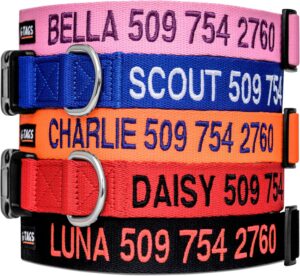 |
Key Points:
|
| Boundary training is essential for your dog’s safety and maintaining home harmony. Indoors, physical markers and commands help establish off-limit areas, while outdoor training uses flags, fencing, or leash guidance to define yard limits. Providing alternatives like a dog bed ensures furniture restrictions are respected. Positive reinforcement through rewards and engaging boundary games fosters obedience and makes training enjoyable.
For tech-savvy solutions, virtual fences and GPS trackers offer effective boundary control outdoors. Training requires patience and consistency, with regular reinforcement to build lasting habits. By understanding and teaching boundaries, you create a structured, safe environment for your dog, fostering discipline and a stronger bond. |
|
Step 1: Establishing Indoor Boundaries
Defining Indoor Boundaries
Dogs may need to avoid certain areas, like the kitchen, bedrooms, or furniture in homes. Identifying and consistently enforcing these boundaries keeps dogs out of potentially harmful situations and promotes a cleaner, more organized household.
Training Tips for Indoor Boundaries
- Create Physical Markers: Use rugs or mats at doorways to indicate where the boundary begins. Dogs are receptive to these visual cues.
- Leash Guidance: During the initial training, use a leash to guide your dog to the boundary line and encourage them to sit and stay.
- Positive Reinforcement: Reward your dog when they respect boundaries, either by sitting patiently or not entering restricted areas.
| Indoor Boundary Tips | Actions |
| Physical Markers | Place mats/rugs at doorways as markers. |
| Leash Guidance | Use a leash to show boundary limits. |
| Positive Reinforcement | Reward when your dog stays in place. |
Using Verbal Cues
Consistent verbal cues help dogs understand their limitations. Words like “Stay,” “Out,” or “Go Back” are useful commands for communicating boundaries. Pair these cues with hand signals, such as an open palm, to reinforce the visual component of the boundary.
Example Technique:
When your dog approaches a restricted area, stand at the boundary, say “Out,” and guide it back. If it retreats, reward it with a treat or praise. Repeat this regularly until it recognizes the limit.
Step 2: Teaching Yard and Outdoor Boundaries
Training outdoor boundaries requires more patience, and it involves larger areas and potential distractions. However, with consistency and reinforcement, your dog can learn to respect these limits.
Techniques for Outdoor Boundary Training
- Mark the Yard’s Boundaries: Use flags, fencing, or natural markers like hedges to create a visible yard outline.
- Leash Training: Walk along the boundary with your dog on a leash, guiding them to understand where they should stop.
- Supervised Off-Leash Training: Once your dog progresses, allow supervised off-leash time while reinforcing boundaries with commands and rewards.
| Outdoor Boundary Techniques | Actions |
| Boundary Markers | Use flags, fences, or natural markers. |
| Leash Guidance | Walk along boundaries on a leash. |
| Supervised Off-Leash Practice | Gradually build trust with commands. |
Using Recall Training Outdoors
Recall training is an essential part of boundary training in larger areas. Teach your dog to come to you when called, strengthening your control over their movements. Start by practicing recall in a safe area, using treats and praise to reward obedience.
Example Technique:
Begin in a fenced yard or park and call your dog’s name, followed by “Come.” Reward them immediately with treats and affection. This reinforcement builds trust and strengthens the command for later boundary training.
Step 3: Introducing Boundaries for Furniture
Many pet owners prefer their dogs to stay off specific furniture items, like sofas or beds. This boundary training ensures cleanliness and provides a designated resting place for your pet.
Steps for Furniture Boundary Training
- Provide an Alternative: Place a comfortable dog bed near the restricted furniture, encouraging your dog to use it instead.
- Use Commands and Rewards: Commands like “Off” or “Bed” help redirect your dog from the furniture to their own space.
- Consistency is Key: Enforce this rule consistently and avoid allowing exceptions. This avoids confusion and reinforces the restriction.
| Furniture Training Tips | Actions |
| Provide Alternatives | Place a dog bed near restricted furniture. |
| Commands | Use “Off” and “Bed” to direct them away. |
| Consistency | Avoid making exceptions to the rule. |
Training with Positive Reinforcement
Dogs respond well to rewards. When they choose to stay off the furniture or lie in their bed instead, provide a treat or affectionate praise. This positive association will encourage them to repeat the behavior.
Step 4: Setting Up Virtual Boundaries with Technology
For tech-savvy pet owners, invisible or virtual fencing systems can provide an additional level of boundary control, especially for outdoor spaces. These systems offer a structured boundary without a physical fence, helping dogs learn their limits safely.
Types of Virtual Boundary Systems
- Invisible Fences: These systems use a boundary wire that emits a mild correction if the dog crosses it.
- GPS Trackers with Boundary Alerts: GPS devices attached to the dog’s collar send alerts if they wander outside a predefined area.
| Virtual Boundary Systems | Description |
| Invisible Fences | Boundary wire emits mild correction if dog crosses. |
| GPS Trackers with Alerts | Sends alerts when dog leaves predefined area. |
Considerations for Virtual Boundaries
Ensure your dog is comfortable and properly acclimated to the system. Start with short training sessions, and never rely solely on these systems—reinforcement through commands and training is essential.
Engaging Boundary Games to Reinforce Limits
Boundary games make training enjoyable and interactive for your dog, reinforcing limits through playful methods.
| Boundary Game | Description | Benefits |
| Place Game | Teach your dog to stay on a designated spot (like a mat) until released. | Reinforces staying in one place, improves patience, impulse control. |
| Red Light, Green Light | Have your dog follow on command (“Green Light”) and stop on command (“Red Light”). | Enhances impulse control, recall, and quick command response. |
| Invisible Line Game | Establish an invisible line at doorways, rewarding the dog for not crossing. | Encourages respect for boundaries within the home, reinforces waiting. |
| Stay and Release | Have your dog stay at a distance, then release with a cue. | Builds focus, reinforces staying in place until permission is given. |
| Out of Bounds | Place treats beyond a set boundary and reward when they don’t reach. | Strengthens self-control and boundary respect, helps resist temptations. |
| Boundary Recall Game | Call your dog from a boundary line and reward them for staying. | Reinforces recall while respecting physical boundaries and limits. |
These boundary games provide enjoyable ways for your dog to practice impulse control and respect boundaries while actively engaging with you.
Effective Techniques and Benefits of Boundary Training
Boundary training covers various aspects, each reinforcing your dog’s respect for limits and control. Here’s a breakdown of the types of boundaries and their respective benefits.
| Boundary Training Aspect | Techniques | Benefits |
| Indoor Boundaries | Use physical markers, leash guidance, commands like “Stay” or “Out.” | Teaches respect for restricted areas, reduces unwanted behaviors. |
| Outdoor Boundaries | Use flags or fences, leash training, recall commands. | Establishes yard limits, prevents wandering, reinforces recall. |
| Furniture Boundaries | Provide alternatives like a dog bed, use commands, consistency. | Keeps furniture clean, reinforces respect for personal spaces. |
| Virtual Boundaries | Use invisible fences or GPS trackers. | Provides boundary solution without physical barriers, improves safety. |
| Boundary Games | Engage in games like “Place Game” and “Invisible Line.” | Builds impulse control, makes training fun, reinforces boundaries. |
| Positive Reinforcement | Reward obedience with treats, praise, or toys. | Encourages desired behaviors, creates positive boundary associations. |
| Training Schedule | Practice daily or weekly based on each boundary area. | Ensures consistency and gradual reinforcement over time. |
Quick Tips for Setting Personal Boundaries with Other Dogs
Teaching a dog to respect boundaries with other dogs is crucial for social harmony and safety. Here are some practical tips:
- Controlled Introductions: Start with calm, on-leash introductions in a neutral area. Allow each dog to sniff and observe at their own pace, without forcing interaction.
- Teach “Leave It” and “Back” Commands: Use commands like “Leave it” or “Back” to encourage respectful distance when one dog becomes too assertive or pushy.
- Reward Calm Behavior: Reward your dog for calm, non-intrusive behavior around other dogs. Reinforce any signs of patience and self-control.
- Use Positive Reinforcement with Distance: Gradually increase the distance between the dogs and reward when they stay relaxed.
- Monitor Playtime: Supervise play sessions closely. If play becomes too rough, use a command like “Enough” or “Gentle” to reset the energy.
- Practice Recall Training: Strengthen recall so they reliably respond when called away from another dog.
- Observe Body Language: Watch for signs of discomfort (e.g., tail tucked, growling), and create distance if needed.
- Use a Parallel Walk Technique: Walk the dogs side by side at a distance before allowing direct contact to reduce tension.
Tips for Boundary Training Success
- Patience and Consistency: Consistency is crucial in boundary training. Always enforce the boundaries, and be patient—your dog may take time to learn and adapt. Gradual exposure, repetition, and reinforcement will make the training more effective.
- Observing Your Dog’s Behavior: Pay attention to how your dog responds to boundary training. If they struggle with specific boundaries, reinforce training in that area with more patience and structure.
Troubleshooting Common Boundary Training Issues
| Common Issues | Solutions |
| Resists Boundaries | Use commands and reward for compliance. |
| Anxiety | Introduce boundaries gradually and calmly. |
Creating a Boundary Training Schedule
A consistent schedule helps solidify boundary training. Here’s a sample boundary training schedule to get you started:
| Training Schedule | Frequency | Activities |
| Indoor Boundaries | Daily for 5–10 minutes | Use leash guidance, verbal commands, and rewards. |
| Yard Boundaries | 2-3 times weekly | Practice leash walking along boundaries. |
| Furniture Training | As needed | Use commands like “Off” and reinforce with rewards. |
| Recall Training (Outdoor) | Weekly | Practice recall in fenced area, rewarding success. |
| Virtual Boundaries Setup | Initial setup, weekly | Familiarize dog with virtual fence or GPS device. |
Top 10 Tools to Help Your Dog Learn and Respect Boundaries
Final Thoughts
Training your dog to respect boundaries requires patience, consistency, and understanding. By using positive reinforcement, practicing regularly, and establishing clear physical or virtual markers, you can create a safe environment for your dog to thrive. Respecting boundaries enhances the bond between you and your dog, promotes discipline, and ensures a harmonious living space for everyone. Start with small steps; with time, your dog will respect your limits, making life easier for both of you.











